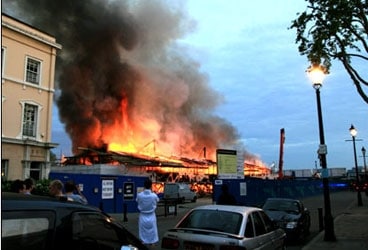
CuttySarkSt
Fire has ravaged the 19th century tea clipper, Cutty Sark, as it sat at its dry dock near the River Thames in Greenwich, England.
The mast and half of the ship’s planking was off-site undergoing restoration at the time of the fire, and the damage that was sustained doesn’t appear to be structural, said Richard Doughty, CEO of the Cutty Sark Trust.
Police are investigating arson as a possible cause of the fire, which broke out in the early morning hours and roused several nearby residents. Andrew Pamthilon, 27, lives 50 yards from the tourist attraction. “I was woken up at 4:30 by what sounded like two large explosions,” he told the BBC. “I ran out into the street and saw huge flames. I could feel the heat from 50 yards away, it was so intense.”
The 138-year-old ship had been undergoing a $49.3 million renovation, the financial troubles of which have only been magnified by the blaze. Dr. Eric Kentley, curatorial consultant to the Cutty Sark Trust, said, “It can be saved. It’s certainly not completely devastated. We will put her back together- but it’s going to take much, much longer and a lot more money than we originally thought.”
Built by Scott & Linton in 1869, Cutty Sark was the last of the great tea clippers, and as such, carries enormous historical significance, said Peter Van der Merwe of the National Maritime Museum in Greenwich.
“It’s one of the most important historic ships in the world. It’s the first merchant ship which was deliberately saved for preservation to represent really the ultimate development of the merchant sailing ships-the fast sailing ships of the nineteenth century.
“It is also constructionally very important,” he continued. “It’s a composite ship built of teak on an iron frame, and it was in its time an extraordinary, famous ship.”
Cutty Sark made eight journeys to China as part of the tea trade before the advent of steam ships rendered it obsolete. The 900-ton ship was later used for training naval cadets during World War II.
For more on this developing story, click here.








